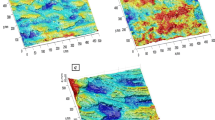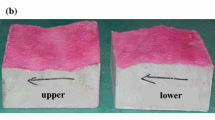Abstract
Replicas were produced of 20 natural rock joints with different roughness. Factors affecting shear strength were examined and direct shear tests were performed using the replica joints to determine their quantitative shear strength characteristics. Results from the shear tests were best fitted by the power law equation, τ = Aσ Bn , where τ is the shear strength and σ n is the normal stress, and regression coefficients A and B were determined. The coefficient A (equal to τ when σ n is 1 MPa) is defined as the friction angle, and B, which determines the curvature of the plot of shear versus normal strength, is a factor that reduces the shear strength. The physical and mechanical properties of the coefficients A and B were defined, and the relationship between these coefficients and the factors affecting shear strength, such as roughness and joint wall strength, were analyzed quantitatively. A new equation, τ = σ Bn tan[ϕ b + ϕ J + s n], was suggested to measure and predict shear strength accurately based on results from these analyses, where ϕ b is the basic friction angle, ϕ J is the joint roughness angle, and s n is the shear component. Although the new shear strength equation is nonlinear, it is as simple to use as a linear equation and the shear strength can be estimated using only three easily measurable parameters (ϕ b , ϕ J , and σ j , the joint wall compressive strength). The failure envelope estimated using the new shear strength equation not only closely matches the measured shear strength, but also reflects the nonlinear relationship between the normal stress and shear strength.



















Similar content being viewed by others
Abbreviations
- σ n :
-
Effective normal stress
- τ :
-
Shear stress
- c :
-
Cohesion
- S j :
-
Apparent cohesion
- ϕ :
-
Friction angle
- ϕ b , ϕ B :
-
Basic friction angle
- ϕ r :
-
Residual friction angle
- i :
-
Dilation angle
- d n :
-
Dilation components
- s n :
-
Shear component
- JRC:
-
Joint roughness coefficient
- JCS:
-
Joint compressive strength
- SRP:
-
Stationary roughness parameter
- I :
-
Non-stationary angle
- a, c, d :
-
Empirical coefficients
- Δϕ :
-
Joint roughness angle
- P N :
-
Median angle pressure
- ϕ m :
-
Friction component
- ψ :
-
Dilation component
- σ T :
-
Shear strength of intact rock material
- \(\theta^{*}_{\text{max} }\) :
-
Maximum apparent gradient of asperities
- C :
-
Roughness parameter
- A 0 :
-
Maximum possible contact area
- UCS:
-
Uniaxial compressive strength
- E :
-
Young’s modulus
- ν :
-
Poisson’s ratio
- Z 2 :
-
Root mean square first derivative values
- Z +2 :
-
Z 2 which analyzes only the positive gradient to shearing direction
- Z 2s :
-
Three-dimensional equivalent of Z 2
- R p :
-
Roughness profile indexes
- R s :
-
Surface roughness coefficient
- A t :
-
Actual area of surface of the joint
- A n :
-
Nominal area of surface of the joint
- D :
-
Fractal dimension of joint
- D s :
-
3-D fractal dimension of joint
- A, B :
-
Regression coefficient of Power law equation
- ϕ J :
-
Joint roughness angle
- ϕ A :
-
Friction angle when normal stress is 1 MPa
References
Alejano LR, Gonzalez J, Muralha J (2012) Comparison of different techniques of tilt testing and basic friction angle variability assessment. Rock Mech Rock Eng 45:1023–1035
Barton N (1973) Review of a new shear strength criterion for rock joints. Eng Geol 7:287–332
Barton N (1976) The shear strength of rock and rock joints. Int J Rock Mech Min Sci Geomech Abstr 13:255–279
Barton N, Choubey V (1977) The shear strength of rock joints in theory and practice. Rock Mech 10:1–54
Belem T, Homana-Etienne F, Souley M (2000) Quantitative parameters for rock joint surface roughness. Rock Mech Rock Eng 33(4):217–242
Bruce IG, Cruden DM, Eaton TM (1989) Use of a tilting table to determine the basic friction angle of hard rock samples. Can Geotech J 26:474–479
Byerlee JD (1967) Frictional characteristics of granite under high confining pressure. J Geophys Res 72:3639–3648
Cottrell B (2009) Updates to the GG-shear strength criterion. Dissertation, University of Toronto
Cox BL, Wang JSY (1993) Fractal surfaces: measurement and applications in the earth sciences. Fractals 1:87–115
Cruden DM, Hu XQ (1988) Basic friction angles of carbonate rocks from Kananaskis country, Canada. Bull Int Assoc Eng Geol 38(1):55–59
Denby B, Scoble MJ (1984) Quantification of power law indices for discontinuity shear strength prediction. In: Proceedings 25th US symposium on rock mechanics. USRMS, Evanston, pp 475–482
Fardin N, Jing L, Stephansson O (2001) Heterogeneity and anisotropy of roughness of rock joints. In: Sarkka P, Eloranta P (eds) Proceedings of the ISRM regional symposium, EUROCK 2001. Balkema, Espoo, pp 223–227
Goldstein M, Goosev B, Pyrogovsky N, Tulinov R, Turovskaya A (1966) Investigation of mechanical properties of cracked rock. In: Proceedings 1st congress ISRM. ISRM, Lisbon, pp 521–524
Grasselli G (2001) Shear strength of rock joints based on quantified surface description. Dissertation, Swiss Federal Institute of Technology (EPFL)
Grasselli G, Egger P (2003) Constitutive law for the shear strength of rock joints based on three-dimensional surface parameters. Int J Rock Mech Min Sci 40:25–40
Grasselli G, Wirth J, Egger P (2002) Quantitative three-dimensional description of a rough surface and parameter evolution with shearing. Int J Rock Mech Min Sci 39:789–800
Hassani FP (1981) A study of the physical and mechanical properties of rocks and their discontinuities. Dissertation, University of Nottingham
Hong ES, Kwon TH, Cho GC (2009) A study on the asperity degradation of rock joint surfaces using rock-like material specimens. J Korean Soc Rock Mech 11(3):303–314 (in Korean)
Horn HM, Deere DU (1962) Frictional characteristics of minerals. Géotechnique 12(4):319–335
Hsiung SM, Ghosh A, Ahola MP, Chowdhury AH (1993) Assessment of conventional methodologies for joint roughness coefficient determination. Int J Rock Mech Min Sci 30:825–829
Huang TH, Doong YS (1990) Anisotropic shear strength of rock joints, In: Barton N, Stephansson O (eds) Proceedings of the international symposium on rock joints. Balkema, Loen, pp 211–218
Huang TH, Chang CS, Chao CY (2002) Experimental and mathematical modeling for fracture of rock joint with regular asperities. Eng Fract Mech 69:1977–1996
ISRM (1978) Suggested methods for quantitative description of discontinuities in rock masses. Int J Rock Mech Min Sci Geomech Abstr 15(6):319–368
Jaeger JC (1959) The frictional properties of joints in rock. Geofisca pura e applicata 43:148–158
Jang BA, Cho JS (1999) A study on shearing characteristics of joint model. J Eng Geol 9(1):69–82 (in Korean)
Jang BA, Kim TH, Jang HS (2010) Characterization of the three dimensional roughness of rock joints and proposal of a modified shear strength criterion. J Eng Geol 20(3):319–327 (in Korean)
Jang HS, Kang SS, Jang BA (2014) Determination of joint roughness coefficients using roughness parameters. Rock Mech Rock Eng. doi:10.1007/s00603-013-0535-z
Kim DY, Lee HS (2009) Quantification of rock joint roughness and development of analyzing system. In: Kulatilake PHSW (ed) Proceedings of the international conference on rock joints and jointed rock masses. Tucson, paper 1019
Krahn J, Morgenstern NR (1979) The ultimate frictional resistance of rock discontinuities. Int J Rock Mech Min Sci 16:127–133
Krsmanovic D, Langof Z (1964) Large scale laboratory tests of the shear strength of rocky material. Rock Mech Eng Geol Suppl 1:20–30
Kulatilake PHSW, Shou G, Huang TH, Morgan RM (1995) New peak shear strength criteria for anisotropic rock joints. Int J Rock Mech Min Sci 32:673–697
Ladanyi B, Archambault G (1970) Simulation of shear behaviour of a jointed rock mass. In: Somerton WH (ed) Proceedings of the 11th symposium on rock mech. AIME, Berkeley, pp 105–125
Lane KS, Heck WJ (1964) Triaxial testing for strength of rock joints. In: Spokes EM, Christiansen CR (eds) Proceedings of the 6th US symposium rock mech. USRMS, Rolla, pp 98–108
Lange DA, Jennings HM, Shah SP (1993) Relationship between fracture surface roughness and fracture behaviour of cement paste and mortar. J Am Ceram Soc 3:589–597
Lee CH, Jeong GC (2002) Anisotropy of shear strength according to roughness in joint surface. J Eng Geol 12(4):421–437 (in Korean)
Lee YH, Carr JR, Barr DJ, Hass CJ (1990) The fractal dimension as a measure of roughness of rock discontinuity profile. Int J Rock Mech Min Sci 27:453–464
Lilly PA (1982) The shear behaviour of bedding planes in Mt. McRae shale with implications for rock slope design. Int J Rock Mech Min Sci 19:205–209
Maerz NH, Franklin JA, Bennett CP (1990) Joint roughness measurement using shadow profilometry. Int J Rock Mech Min Sci 27:329–343
Maksimovic M (1992) New description of shear strength for rock joints. Rock Mech Rock Eng 25:275–284
Maksimovic M (1996) The shear strength components of rough rock joint. Int J Rock Mech Min Sci Geomech Abstr 33(8):769–783
Newland PL, Allely BH (1957) Volume changes in drained triaxial tests on granular materials. Géotechnique 7:17–34
Papaliangas TT, Hencher SR, Lumsden AC (1995) A comprehensive peak shear strength criterion for rock joints. In: Fuji T (ed) Proceedings 8th international congress on rock mechanics. Balkema, Tokyo, pp 359–366
Park JW, Song JJ (2013) Numerical method for the determination of contact areas of a rock joint under normal and shear loads. Int J Rock Mech Min Sci 58:8–22
Patton FD (1966) Multiple modes of shear failure in rock and related material. Dissertation, University of Illinois
Reeves MJ (1985) Rock surface roughness and frictional strength. Int J Rock Mech Min Sci 22:429–442
Richards LR (1975) The shear strength of joints in weathered rock. Dissertation, University of London, Imperial College
Seidel JP, Haberfield CM (1995) Towards an understanding of joint roughness. Rock Mech Rock Eng 28:69–92
Stimpson B (1981) A suggested technique for determining the basic friction angle of rock surfaces using core. Int J Rock Mech Min Sci Geomech Abstr 18:63–65
Tatone BSA, Grasselli G (2010) A new 2D discontinuity roughness parameter and its correlationship with JRC. Int J Rock Mech Min Sci 47:1391–1400
Tse R, Cruden DM (1979) Estimating joint roughness coefficients. Int J Rock Mech Min Sci 16:303–307
Turk N, Gerd MJ, Dearman WR, Amin FF (1987) Characterization of rock joint surfaces by fractal dimension. In: Farmer I et al (eds) Proceedings of the 28th US symposium on rock mechanics, Tucson. Balkema, Rotterdam, pp 1223–1236
Wakabayashi N, Fukushige I (1995) Experimental study on the relation between fractal dimension and shear strength. In: Myer LR, Cook NGW, Goodman RE, Tsang CF (eds) Fractured and jointed rock masses. Balkema, Rotterdam, pp 125–131
Wu TH, Ali EM (1978) Statistical representation of the joint roughness. Int J Rock Mech Min Sci 15:259–262
Yang ZY, Chiang DY (2000) An experimental study on the progressive shear behavior of rock joints with tooth-shaped asperities. Int J Rock Mech Min Sci Geomech Abstr 37:1247–1259
Yang ZY, Lo SC, Di CC (2001) Reassessing the joint roughness coefficient (JRC) estimation using Z2. Rock Mech Rock Eng 34:243–251
Yu XB, Vayssade B (1991) Joint profiles and their roughness parameters. Int J Rock Mech Min Sci 28:333–336
Acknowledgments
This research was supported by the Basic Science Research Program of the National Research Foundation of Korea (NRF), funded by the Ministry of Education, Science and Technology in Korea (2011-0007281).
Author information
Authors and Affiliations
Corresponding author
Rights and permissions
About this article
Cite this article
Jang, HS., Jang, BA. New Method for Shear Strength Determination of Unfilled, Unweathered Rock Joint. Rock Mech Rock Eng 48, 1515–1534 (2015). https://doi.org/10.1007/s00603-014-0660-3
Received:
Accepted:
Published:
Issue Date:
DOI: https://doi.org/10.1007/s00603-014-0660-3




